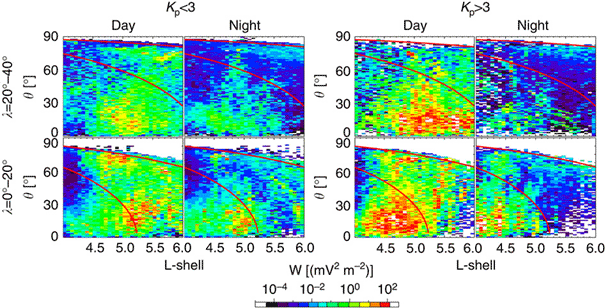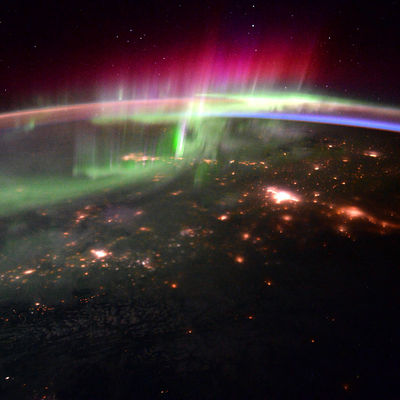Atmospheric Electricity – Atmosphere/Ionosphere coupling
For this theme, our research work is divided into three main classes:
– Theoretical research on the physics of Transient Luminous Events (TLE).
– Theoretical research on the physics of Terrestrial Gamma ray Flashes (TGF).
– Experimental research, via DEMETER data, on phenomena associated with thunderstorms such as TLE parent lightning, lightning-induced electron precipitation and energetic electron beams.
Among the many results obtained, we can highlight: the quantification of the role of ionospheric conditions in the production, morphology and polarity of Sprite-type atmospheric discharges; the prediction of light emissions associated with the acceleration of relativistic electrons producing TGFs; the discovery of a thunderstorm-induced escape from the Earth’s very high atmosphere.
The atmospheric electrical activity is also a subject of interest for the LPC2E Atmosphere team. Consequently there are common actions on this topic, in particular the OREO balloon project for the study of thunderstorms as well as work on the modeling of the impact of LETs on the physicochemistry of the atmosphere.
- Our integration in the scientific community of Atmospheric Electricity leads us to participate in various national and international programs:
- European Science Foundation collaborative research program TEA-IS [Thunderstorm Effects on the Atmosphere-Ionosphere System, 2011-2016].
- Activity LAboratory of MUlti-Satellite Studies of Atmosphere-Ionosphere Electric
Coupling of the French-Russian GdRI Helio-Plasmas. - SOLID project [Space-basedOptical LIghtning Detection, LA Toulouse].
- Interdisciplinary project LICORNE [LIghtning and COsmic Rays in Natural Environment, EMN/Subatech].
Ionosphere/Magnetosphere/Solar Wind Coupling
The research carried out at LPC2E on the couplings between Ionosphere, Magnetosphere and solar wind is organized around the data of the Cluster and DEMETER.
Use of DEMETER data: DEMETER is the first space mission for which the LPC2E was responsible (scientific payload and data center). The mission is stopped since the end of 2010 but the exploitation of the data continues with as much intensity. It allowed to highlight in the ionosphere a very large variety of waves at various frequencies not only in the auroral zones but also at mid-latitude and in the equatorial region. Although the question of the causal link between seismic activity and ionospheric disturbances is still partly open, DEMETER is an undeniable scientific and technical success, which has been supported by numerous collaborations, in particular via the FP7 project SEMEP (Search for Electro-Magnetic Earthquake Precursors combining satellite and ground-based facilities, 2010-2012).
Use of Cluster data: the scientific interest of Cluster data is not denied and the end of the operational period is now extended beyond 2020. Within the team, studies on Ionosphere/Magnetosphere couplings have led to important scientific results. In the framework of CNES/ONERA – CEA contracts we have generated a database of low frequency wave measurements in the inner magnetosphere (data from Cluster, THEMIS, DE1, Polar, CRRES and Akebono). The analysis of this database has allowed to highlight the importance of oblique whistling waves for the processes of diffusion, loss and acceleration of particles (Figure 1).

Figure 1. Whistler wave energy distribution inside radiation belts [Artemyev et al., 2015]
Concerning the coupling Magnetosphere/Solar Wind, the analysis of cluster data during the crossing of the Earth shock allowed us to show that the structure of the shock front is similar to that of a nonlinear wave of the whistling type. This explains all the observations (generation of “precursor” waves before the shock, distribution of the characteristic scales of the variations of the magnetic and electric fields, characteristic scale of the change of the electronic temperature during the crossing of the front). Still on this topic, the magnetic reconnection at the magnetopause has been studied by 3D kinetic simulations and MMS data. In the last few years, the study and the modeling of the beam-plasma interaction and of the Langmuir wave production in the solar wind have become a particularly active and productive research area at LPC2E.
The exploitation of Cluster’s WHISPER sounder continues, including studies on plasmasphere filling and emptying. WHISPER also provides the Cluster community with a much needed absolute measurement of electron density.
Contact LPC2E : jean-louis.pincon@cnrs-orleans.fr

